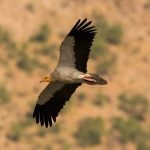The monitoring of the Egyptian Vulture (𝘕𝘦𝘰𝘱𝘩𝘳𝘰𝘯 𝘱𝘦𝘳𝘤𝘯𝘰𝘱𝘵𝘦𝘳𝘶𝘴) population is an initiative that study groups (from 14 countries in the Balkans, Africa and the Middle East), within the framework of LIFE project “Egyptian Vulture New Life”, undertake year after year to identify changes in population or distribution of territories in the Balkans or Africa. This monitoring serves to understand the progress and to identify the necessary measures for the recovery of the population of this vulture, which is classified as Globally Endangered by IUCN.
Monitoring the Egyptian Vulture in Albania, like every year, is an engaging activity, which requires dedication and spending a long time in the nesting territories to generate the necessary data, such as occupied territories, number of breeding pairs or individuals, the offspring, etc. At the end of this process, the working group, AOS and PPNEA announce the following results:
𝗜𝗻 𝗔𝗹𝗯𝗮𝗻𝗶𝗮, 𝗻𝗶𝗻𝗲 𝘁𝗲𝗿𝗿𝗶𝘁𝗼𝗿𝗶𝗲𝘀 continue to remain 𝗼𝗰𝗰𝘂𝗽𝗶𝗲𝗱, as in the previous three years. 𝗦𝗶𝘅 𝘁𝗲𝗿𝗿𝗶𝘁𝗼𝗿𝗶𝗲𝘀 are occupied 𝗯𝘆 𝗯𝗿𝗲𝗲𝗱𝗶𝗻𝗴 𝗽𝗮𝗶𝗿𝘀 𝗮𝗻𝗱 𝘁𝗵𝗿𝗲𝗲 𝗯𝘆 𝘀𝗼𝗹𝗶𝘁𝗮𝗿𝘆 𝗶𝗻𝗱𝗶𝘃𝗶𝗱𝘂𝗮𝗹𝘀. Although the number of territories remains unchanged, unfortunately, the loss of an old territory has been noticed but at the same time, thankfully, the case of a new territory has been reported.
At the Balkan level, there has been a 9 % increase in the number of breeding pairs monitored, two of which were identified in Bulgaria, one in Albania and one in Greece. Unfortunately, the number of fledglings was lower than last year.
Poisoning remains one of the main factors in the drastic decline of the Egyptian vulture population in the Balkans. In addition, electric shock, collision with power line infrastructure and disturbance during the nesting season are threats that make it difficult for this species to survive. In this regard, researchers from all partner countries have joined forces to implement concrete measures to prevent and minimize these risks, both in the nesting territories and along the Egyptian vulture’s migration route.
This activity was carried out under the frames of the LIFE+ project “Egyptian vulture New LIFE” (LIFE16 NAT/BG/000874).





